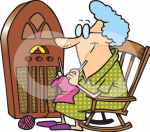3UZ
Melbourne
Mid-1930s
Tthe Melbourne mediumwave commercial station 3UZ carried out special shortwave
tests on 32 metres (about 9375 kHz) on Mondays, Wednesdays and Saturdays between 7 pm
and 9 pm local time. A transmitter of 120 watts was used, crystal controlled, and was designed and built by the Chief Engineer
of 3UZ at the time, Mr L. G. Glew. This was one of the very few occasions that this type of dual shortwave/mediumwave had
been carried out. At that time, the mediumwave transmitter was only 500 watts.
3LO Melbourne
Mid-1927
The
Broadcasting Company of Australia, which operated station 3LO in Melbourne, on mediumwave, had been devoting considerable
time and effort to the question of a regular international Broadcasting Service, and had decided to install a shortwave transmitter.
At about the same time, the shortwave station operated by the AWA Company, in Sydney, Amalgamated Wireless of Australia had
successfully carried out telephony tests on shortwave for reception in England, such as those heard on June
22.
1927
Experimental work in Melbourne
continued, which resulted in the construction of a new shortwave transmitter, built by AWA, and which was installed at the
AWA transmitting site at Braybrook, where the medium wave facility of 3L0 was located. 3LO was later relocated to the Sydenham
site, where it was to share the newly built mast with 3AR.
Braybrook is now an industrial suburb, west of the city
of Melbourne.
This new transmitter was tested for several weeks, using Morse, and was successfully received throughout
the world, on 10070 kHz (29.8 metres). Antenna power was 3 kW. It was intended that this new shortwave transmitter would form
the basis of a regular overseas service for Europe and America.
September 7 1927
The first broadcast of this new
transmitter took place, from midnight through until 5 am. It went on air on the new frequency in the 32 metre band of 9375
kHz, a slight change from the frequency used for the tests. The broadcast commenced as soon as the regular medium wave service
of 3LO closed down.
It created a record for Australia for the length of time and variety seen. More than 80 people
were in the studio that night - everyone above the rank of working journalist was in evening clothes and a report in the "Listener In" of September 14, 1927 said that "the dressing of the ladies was
resplendent”
The program featured speeches, musical items, correspondents’ reports,
editorial items, and news originating from the studios of the Melbourne "Herald", The "Million Shilling Fund" was
brought to the world, as were musical items from Joe Aronserfs "Synco Symphonists" and the Collingwood Citizens Band.
The broadcast continued right throughout the night until around 5 am, and the
first indication that it was being heard outside of Australia came just before 1.00 am, when the station in Java announced
that they were hearing the program without difficulty. PCJJ and the British Broadcasting Company both announced that the station
had begun to fade in in the European area.
As well as the overseas listeners, the station-hoped to attract a substantial
number of listeners from within Australia, who sat up until midnight to hear this historic broadcast.
Of interest is this announcement which was given at midnight: "This is station 3LO Melbourne Australia broadcasting on a wavelength of 32 metres".
Major Condor, Manager of the Australian Broadcasting Company read an address prepared by the Prime Minister, Mr Bruce.
By all accounts, this international broadcast from Melbourne was a tremendous
success.
3ME started out on 9375 kHz, but which was changed to 9507 around 1935. Its schedule
then was 8 pm to 10 pm, on Wednesday and Saturday nights.
October 1936, its schedule had changed to 7 pm to
10 pm, Mondays to Saturdays, and there was a Mailbag Session on Wednesdays at 9 pm; the frequency had been adjusted to 9510
kHz.
1935 to 1936
Operations were also on 9520 kHz in
those years.
1936
The 3ME opening signal was a series of clock chimes.
1939
3ME was closed down by the Government at the onset of WW2

